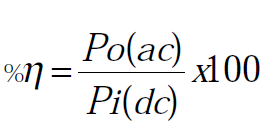It is a fixed bias circuit
DC bias operation
The DC bias set by Vcc and Rb
Collector current IC=βIB
Collector –emitter voltage
VCE=VCC-ICRC
Load line
Power considerations
Ø The power into an amplifier is provided by the power supply
Ø With no input supply, current drawn is collector bias current ICq.
pi(dc)=VCCICq
Output power
Ø The output voltage and current varying around the bias point provide ac
power to the load.
Using rms signals
Ø P0(ac)=VCE(rms)IC(rms)
=I2
C(rms) Rc
=V2
C(rms)/Rc
Ø Using peak signals
The ac power delivered to the load is
p0={VCE(p) IC(p)} / 2
or = {I2
c(p)/2} Rc
={V2
CE(p)}/2Rc
Ø Using peak-peak signals
P0(ac)={VCE(p-p) IC(p-p)}/8
= {I2
c(p-p)/8} Rc
={V2
CE(p)}/8Rc
Efficiency
Ø Efficiency of an amplifier represents the amount of ac power delivered from
dc source. It can be calculated using
Maximum Efficiency
Ø Maximum voltage swing VCE(p-p)=VCC
Ø Maximum current swing IC(p-p)=VCC/RC
Ø Maximum power
Ø The maximum power input evaluated using dc bias current set to half of the
maximum value….
Ø Maximum Pi(dc)=VCC(maximum IC)
Ø Maximum efficiency = {maximum Po(ac)/maximum Pi(dc)} x100
= 25%
Maximum efficiency
Ø The maximum efficiency of a class A series fed amplifier is thus seen to be
25%.
Ø The maximum efficiency occurs only for ideal conditions of both voltage
and current swing .thus practical circuits will have less than this percentage.











0 comments